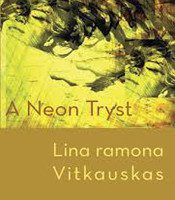The dense, allusive poems of Lina Vitkauskas’s A Neon Tryst are what the speaker calls “Black Patent Translations to L’Eclisse” (1962 film written and directed by Michelangelo Antonioni, starring Alain Delon and Monica Vitti), “Wilson, 722 to Seconds,” and “Into the Black Flocks to Wild Strawberries” (the latter two directed by directed by John Frankenheimer and Ingmar Bergman, respectively).
Ramon Fernandez’s (Wallace Stevens’ erstwhile muse in “The Idea of Order at Key West”), epigraph to Walter Benjamin 1936 essay “The Author as Producer” essay cinches the knot between the cinematic and literary imaginaries: “Il s’agit de gagner les intellectuels à la classe ouvrière, en leur faisant prendre conscience de l’identité de leurs démarches spirituelles et de leur condition de producteurs.” For the working class and the intellectual class deny the existence of the other, is to deny both their spiritual dignity as well as the politics of production.
Vitkauskas transposes the fissures between the scripting and staging (acting, directing, and producing) to a contemporary frame: her chosen muses (Antonioni’s “cinema of possibilities” favoring mood over action, and image and design over narrative; Frankenheimer’s psychological dilemmas; and Bergman’s privileging of sense over what he called “merely intellectual films”), suit her own aesthetic, teasing nonsense out of sense, and, scales of music, out of logocentric, manmade scales of “justice” (law) well.
The speaker of A Neon Tryst is, alternately, an embodiment of the actors in the three films, and a personae of the poet (happily amplifying the tension between “trace” and “tryst” in European theory and culture) herself, confronting the modernity of Antonioni’s films head-on, with a panoply of postmodern stylistics. Neon: a hallucinatory color spectrum beyond the color wheel, and a means of representation beyond the sign. Tryst, the erotics of an encounter, rather than an intimate bond: what Emmanuel Lévinas termed the irreducible relation of a face-to-face encounter with the other (in which the other person’s proximity and distance are strongly felt, however fleetingly). In L’Eclisse, the tryst is between Vitti and Francisco Rabal, who split up, after which Vitti begins a new tryst with Piero (Alain Delon), plot points begging the question of how to remain faithful to a source text, genre, or role, moving between art forms or mediums.
From silent films to talkies, black and white photography to color images, the speaker of these poems announces her arrival on the vertiginous event horizon of post-history elliptically, in schizoid asides (“I have Sigbritt’s doll,/ I made the dress myself”). In all three film synopses, the interior of the actor is dramatized by the poetic speaker, refusing complicity with the specularization and projection of the female subject (a linguistic slot or metaphysical void, only recognizable as a projection of male fantasies). The speaker is alternately Vitti or another actor, and, when the camera (point-of-view) retracts, the speaker of the poem (commenting, like the Greek Chorus, on the action, without acting) resurfaces, in crises both interpretive and of design.
From “You may have problems at first”:
. . . Cocktails embellish my posture,
Surround my easel and signature.
Rags, turpentine, professionals.
So I attempt form and figure . . .
Elsewhere, the speaker records the act (and surveillance) of desubjectivized labor, yet lacks (even with said interiority) the ability to see her own position as that of the beheld rather than the beholder (the actor, not producer).
From “Wicker clouds”:
I look for absolutes:
This walnut door is absolute,
The placid cleaning woman
Is absolute, a man boxing
Passionate with a model
Ship is absolute.
Here I am immaculate . . .
The choices available to women actors (in the actor-network or commodity-producer dialectics) have historically been to lose oneself in a role (the argument for absorptive art over theatricality), eschewing the Derridian fantasy of difference, contained in the presence of meaning, or the trace (what a sign differs/defers from: the absentia of a sign’s presence).
 Woman must write herself, despite the packaging of art as illness for women (the wandering pen threatening to either express or locate the wandering womb, as Kristeva notes). Whether one accepts a Hollywood typecast or self-authorize, either way the challenge becomes how to seek validation as a guarantor of presence, in not just a male other, but an other (or audience).
Woman must write herself, despite the packaging of art as illness for women (the wandering pen threatening to either express or locate the wandering womb, as Kristeva notes). Whether one accepts a Hollywood typecast or self-authorize, either way the challenge becomes how to seek validation as a guarantor of presence, in not just a male other, but an other (or audience).
False artisan,
call me a cutlet of my throat,
grant me a wish to be old again . . .
I am forged. Already established.
Mildly successful.
Surreal, primitive, impressionist, whatever.
I am accepted.
If film, as Bergman said, was his demanding mistress, so too is the artifice of poem-making, for Vitkauskas, within the performance laboratory (private and staged) of the feminine, the culmination of which is not a recapitulation of power dynamics but an entry into the mystery of co-constitutive powers of existence and legitimization rather than the one-way mirror of the panopticon (male) gaze, wherein, as John Berger notes, men look at women, and women (twice-alienated as objectified by the other, and the self) watch themselves being looked at. In a dissolution of formalist aesthetics, color (tone, mood) replaces structure, and (poetically and as brushstroke), line. Beyond neon, however (Technicolor redoubling of cinematic projection, credit economies, and all meta-realities), one finds the other, and sentience’s hue and cry.




